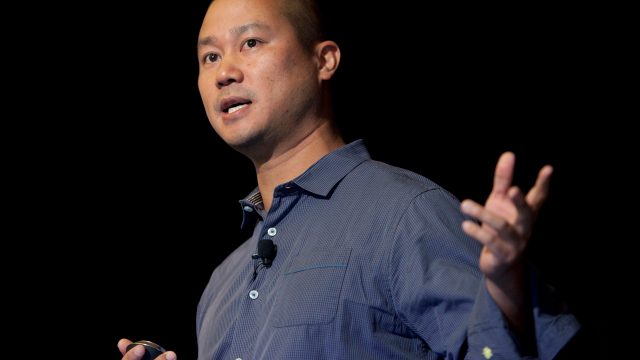Tony Hsieh was a revolutionary figure in the fashion and technology industries.
The cofounder of Zappos.com, who died on Nov. 27 at the age of 46 due to injuries sustained during a house fire, was celebrated for establishing the footwear giant all while creating a unique company culture through his generous and friendly spirit.
Here, WWD looks at six facts to know about Tony Hsieh. Read on for more.
1. Hsieh Was Initially Skeptical About Joining Zappos
Zappos’ origin story is a well-known one, as Hsieh has recounted the tale many times during speaking engagements and in his New York Times bestseller, “Delivering Happiness: A Path to Profits, Passion and Purpose.”
Hsieh wrote about Zappos’ inception in a 2010 article for the Harvard Business Review, writing: “At first I thought that selling shoes online sounded like a poster child for bad Internet ideas.”
He was later sold on the idea thanks to a voicemail Zappos cofounder Nick Swinmurn left with Hsieh’s venture capital fund, Venture Frogs, stating one fact that resonated with Hsieh: “It was the fact that 5 percent of a $40 billion shoe business was already being done through mail order,” Swinmurn told WWD’s sister publication, Footwear News, in 2009.
2. Hsieh Revitalized Downtown Las Vegas
Hsieh launched the Downtown Project in 2012, an initiative to revitalize downtown Las Vegas to make it community-focused.

Related Gallery
Spring 2021 Trend: Black Mode
The project has allocated $350 million toward revitalizing the area, with $200 million going to real estate and development, $50 million going to small businesses, $50 million going to technology and start-ups and $50 million funding arts and culture, education and health care.
“We are thinking of the city as a start-up,” Hsieh said during Footwear News’ 2013 CEO Summit on the project. “We want it to be the anti-Strip — with bars and coffee shops.”
3. He Introduced a Unique Company Culture
Zappos introduced a new corporate model in 2015, replacing managers with a new form of self-organization called holacracy.
“Like all the bold steps we’ve done in the past, it feels a little scary,” he wrote in a blog post, “But it also feels like exactly the type of thing that only a company such as Zappos would dare to attempt at this scale.”
Holacracy is a decentralized management style where authority and decision-making are distributed across teams rather than exclusive to higher executives or management.
4. Hsieh Described His Book as a ‘Stream of Consciousness’
In an interview with Footwear News in 2010 about “Delivering Happiness: A Path to Profits, Passion and Purpose,” Hsieh described the book as a “stream of consciousness.”
Hsieh worked on the book in Lake Tahoe with his close friend Jenn Lim, chief executive officer of Delivering Happiness, a company the duo founded to provide companies with “culture coaching.”
“We didn’t really stick to an outline,” Hsieh explained. “It was more stream of consciousness.” He stated he would write 2,000 to 3,000 words at a time and send them off to his editor.
“We went to Staples the first day we got there and bought a bunch of paper, a printer, colored index cards and a bunch of stickies — everything you can imagine,” Lim said. “But we didn’t end up using any of it.”
5. He Met Zappos’ Chief Finance Officer While Working at a Pizza Parlor
Hsieh met Alfred Lin — who would later serve as the chief finance officer, chief operating officer and chairman of Zappos — while he was working at a pizza parlor during their time at Harvard.
According to Hsieh, Lin kept buying whole pizzas from him to later sell per slice for profit in his dorm. The two clicked early on and joined forces for Hsieh’s LinkExchange Internet advertising company, which he later sold to Microsoft for $265 million.
6. He Paid His Employees to Quit
Along with his unique company culture, Hsieh introduced a new revolutionary practice at Zappos: paying unhappy employees $2,000 to quit. The initiative, which Hsieh dubbed “The Offer,” gave employees the bonus after they completed a four-week training period and decided to not continue with the company. The bonus was meant to weed out employees who were not committed or passionate about the company.
Zappos continued the practice after it was acquired by Amazon in 2009 for 10 million shares of Amazon stock, which Hsieh said were worth $1.2 billion.
Read more here:
Investigation Into Fire That Led to Tony Hsieh’s Death Remains ‘Active’
Zappos Launches Customer Service Hotline to Help Those in Quarantine
The Biggest Fashion News Stories of 2020
WATCH: J Balvin On the Deeper Meaning Behind His Air Jordan Collaboration
Source: Read Full Article
